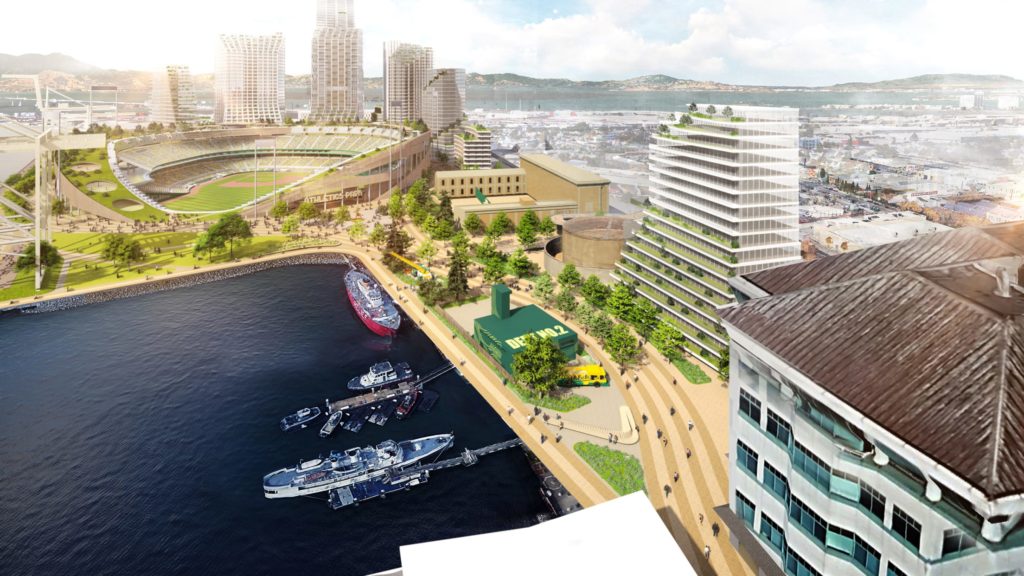
In a surprising and significant move, the state Seaport Planning Advisory Committee recommended that the Oakland Athletics be denied permission for an $12-billion development at the Howard Terminal site that would include a new ballpark.
The advisory 5-4 vote, while not binding, is expected to carry weight with the San Francisco Bay Conservation and Development Commission (BCDC), which will next consider the issue in May before a June 2 vote.
The A’s are proposing the downtown Howard Terminal waterfront development, featuring $12 billion in private investment, including a billion dollars for a new 35,000-capacity ballpark to replace the Oakland-Alameda County Coliseum as the team’s home. The development would also include 3,000 units of housing, as well as 1.5 million square feet of office space, 270,000 square feet of retail space, a 400-room hotel, 18 acres of parkland and an estimated $450 million in community benefits. It would represent a massive makeover of the Oakland waterfront, transforming a industrial site into a mixed-use development.
The rationale for recommending against the development: because of potential growth of traffic through the terminal, the committee says the Port of Oakland should be reserved strictly for shipping in future years, based on anticipated growth. That anticipated growth, however, is a matter of debate, with the assumption of 2 percent annual growth–a mark that’s not been reached in the last decade. (Technically, Howard Terminal is just a storage area, last used for cargo in 2013.) From the Mercury News:
“We are very disappointed that an unelected body, this advisory group, would basically choose a parking lot over a privately financed ballpark and housing development,” A’s President Dave Kaval said in an interview after the 4 1/2-hour meeting.
“I think it just demonstrates how challenging it is and how many approvals are still required to get to a greenlight in Oakland. And it demonstrates why it’s really been important for us to have parallel paths in both Las Vegas and in Oakland,” Kaval added, referring to the team’s threat to move to Nevada rather than continue playing at the Oakland Coliseum.
“This is a very big deal,” Jim McGrath, chairman of the seaport committee and a member of BCDC, said after the vote. “This is a very controversial project. This is not easy for any of us, including the public,” added McGrath, who voted against the ballpark.
Indeed. California already presents a challenging environment for developers, and the sheer size of the $12-billion development combined with the waterfront site adds several layers of complexity for the Athletics ownership. The A’s and Oakland Mayor Libby Schaaf have already seen some victories along the way, and it will be interesting to see how the BCDC votes: it’s easy to make a decision like this when it’s merely an advisory vote with no consequences, but it’s another matter when your vote matters and there are jobs and real-world consequences on the line.
Rendering courtesy Oakland Athletics.
RELATED STORIES: As new Oakland ballpark plan moves forward, Las Vegas becomes long-shot bet; Oakland City Council OKs new ballpark EIR; Oakland Planning Commission approves A’s ballpark EIR; A’s reportedly looking at Tropicana for Vegas ballpark site; A’s succeed in launching bidding war in Las Vegas; A’s ask for feedback on Las Vegas Strip ballpark; Alameda County approves Oakland waterfront ballpark plan; Oakland urges Alameda County support of new ballpark tax district; Alameda County to discuss Athletics ballpark Oct. 26; A’s to narrow field of Vegas sites after playoffs; three sites cited by locals; Alameda County to A’s: Slow down, cowboy; A’s brass resumes Vegas runs, continues talks with Oakland; Oakland, A’s to resume ballpark talks; State funding on tap for new Oakland ballpark?; A’s: Maybe we can work with Oakland on new ballpark terms; Oakland presents term sheet for new ballpark; A’s immediately reject it
